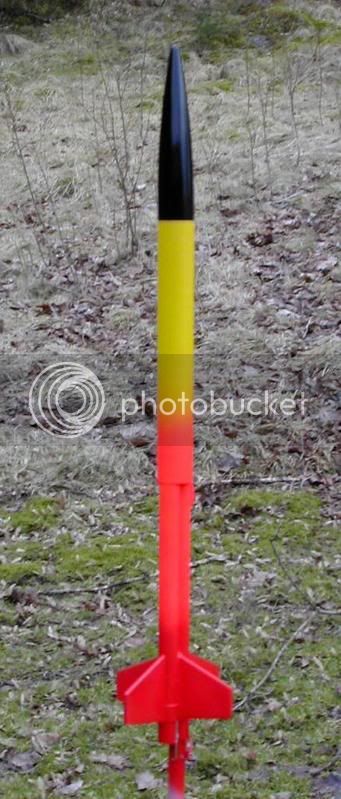Balltip
Well-Known Member
- Joined
- Feb 20, 2006
- Messages
- 988
- Reaction score
- 0
After experiencing my first clustered flight I thought I'd also post a build thread regarding the rocket that I used.
You can find a picture of the *prototype* rocket here: https://www.rocketryforum.com/showthread.php?s=&threadid=34074
This thread will be showing prototype number two (or shall I say the "final idea"? Errrrr... That was actually a rather cool name for a rocket! I might change it to that now LOL!)
Anyway, the rocket is pretty basic but do involve some tweaking of the materials used that I personally have not seen before. But I don't take credit for inventing anything - there are many things that I have not seen before.
A parts list would be as follows:
1 piece of BT56, 24.5 cm long (9.6") for main body tube
2 pieces of BT20, 30 cm long (12") for motor mounts
2 motor hooks (preferably made from window wiper blade springs)
2 engine blocks to fit inside BT20
1 scrap piece of BT20, approx 3cm or 1½"
1 length of Kevlar thread (30 cm / 12") shock cord mount
1 Nose cone (Estes BT56 PNC, like the ones that you get from Red Arrow Hobbies, or a cone of your own choice)
4 fins made from balsa, 3mm or 1/8" thick (Fin measurements will be posted later in the thread)
Note: Edited on June 14, due to flaw to the parts list. Now it should be okey-dokey though.
You can find a picture of the *prototype* rocket here: https://www.rocketryforum.com/showthread.php?s=&threadid=34074
This thread will be showing prototype number two (or shall I say the "final idea"? Errrrr... That was actually a rather cool name for a rocket! I might change it to that now LOL!)
Anyway, the rocket is pretty basic but do involve some tweaking of the materials used that I personally have not seen before. But I don't take credit for inventing anything - there are many things that I have not seen before.
A parts list would be as follows:
1 piece of BT56, 24.5 cm long (9.6") for main body tube
2 pieces of BT20, 30 cm long (12") for motor mounts
2 motor hooks (preferably made from window wiper blade springs)
2 engine blocks to fit inside BT20
1 scrap piece of BT20, approx 3cm or 1½"
1 length of Kevlar thread (30 cm / 12") shock cord mount
1 Nose cone (Estes BT56 PNC, like the ones that you get from Red Arrow Hobbies, or a cone of your own choice)
4 fins made from balsa, 3mm or 1/8" thick (Fin measurements will be posted later in the thread)
Note: Edited on June 14, due to flaw to the parts list. Now it should be okey-dokey though.





